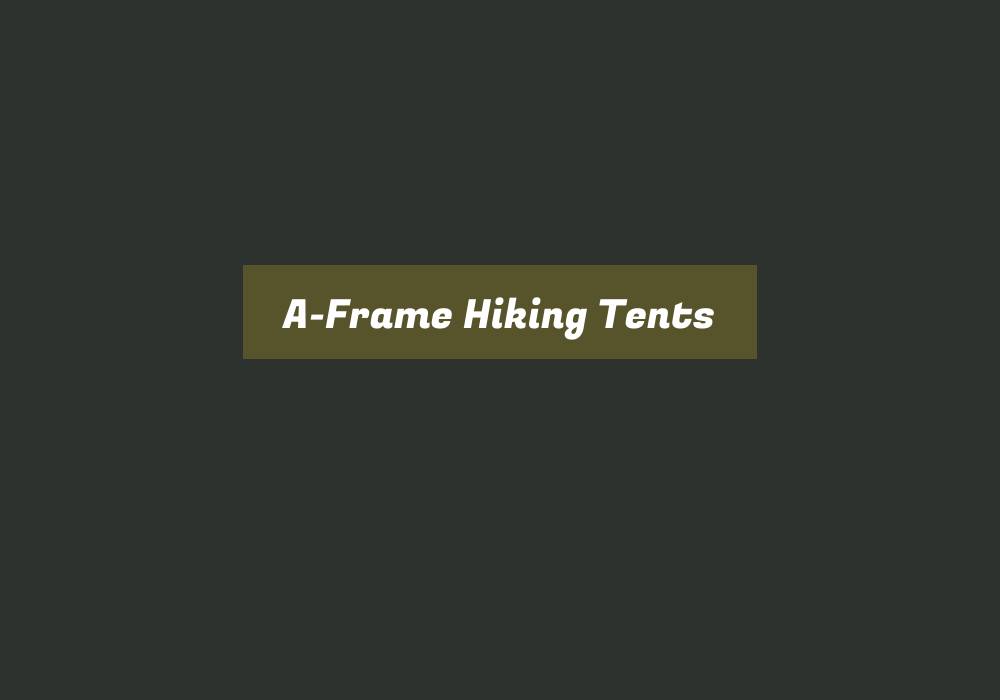A-frame tents are a classic style of lightweight backpacking shelter ideal for thru-hiking and other backcountry adventures. Their steeply angled double-wall construction provides a space-efficient interior room combined with stability and weather resistance. Modern A-frame tents integrate updated materials and design features while retaining the iconic sloped roof silhouette and generous vestibules.
This comprehensive guide will overview A-frame tent benefits, key components, differentiators from other tent styles, considerations for materials and features, brands to look for, and tips for maximizing livability. Let’s explore how current A-frame tent options can provide the ultimate portable shelter on the trail!
Benefits of A-Frame Hiking Tents
A-frame designs offer these advantages for backcountry campers:
- Excellent rain and wind-shedding ability
- More interior headroom than dome tents
- Two large vestibules for gear storage
- The ideal balance of weight, space, and durability
- Distinctive therapeutic feel of the protected enclosure
Modern A-frames enhance the benefits further through technical fabrics, easy setup, and cross-ventilation capabilities.
Main Components of A-Frame Tents
While specifics vary across models, these are the core A-frame tent components:
- Curved roof poles meet at the peak to create a sloped A-frame shape
- Rain fly with vestibules extends past sidewalls for protection
- The floor is bathtub style with edges raised to prevent moisture seepage
- Mesh inner tent provides bug protection while allowing airflow
- Guy out points and lines maximize structure stability
- Stakes, clips, and adjustable tensioners customize the pitch
Higher quality tents use robust yet lightweight poles, durable and waterproof fly fabrics, and strong stake-out points suited to varied terrain.
Differentiators from Other Tent Styles
A-frame designs differ from other tent styles in a few key ways:
Dome Tents
- Lower profile sheds wind less efficiently
- Tend to feel more confining
- Curved walls can reduce usable space
Cabin Tents
- Heavier and bulkier, not optimized for backpacking
- Typically have lower quality materials
- Only water resistance requires an additional fly
Ultralight Tarps
- Provide coverage only, with no bug or moisture protection
- Require trekking poles or tree branches for setup
- Less floor space than in an enclosing tent
Hammock Tents
- Require trees and lack flooring for sleeping
- Condensation and warmth retention can be problematic
- Heavier than non-suspended tent options
Key Considerations for A-Frame Tent Selection
Focus on these performance factors when choosing an A-frame tent:
Weight
- Trail weight under 5 lbs ideal for solo thru-hiking
- Can be under 2 lbs for ultralight tarps without bug protection
Packed Size
- Fits in a standard backpacking pack around 20-30L size
- Easy to split and share weight if camping with a partner
Doors and Vestibules
- Dual doors and vests provide easy ins and outs and dry storage
- Extended vests protect openings from rain drips and wind
Ventilation
- Mesh inners and ceiling vents circulate airflow to minimize condensation
Ease of Setup
- Quick pitch with a color-coded clip system and minimal loose parts
- Practice before the trip to get the routine down
Durability and Weather Resistance
- Sturdy zippers, high denier ripstop nylon, quality waterproof coatings on floor and fly
Top A-Frame Tent Brands
These companies lead the way in A-frame tent design and materials:
- Big Agnes: Lightweight, easy setup tents ideal for thru-hiking including the popular Copper Spur HV model.
- NEMO: Innovative pole configurations and technical fabrics make their A-frame tents like the Hornet livable for their weight.
- MSR: Legendary brand crafting sturdy A-frame models like the Hubba Hubba for three-season backpacking.
- Tarptent: Make ultralight single-wall trekking pole tents without bug protection for maximum minimalism.
- Zpacks: Use proprietary Dyneema composite material to create radically light two-person shelters like the Plexamid.
- Hyperlite Mountain Gear: Bomber ultralight tents designed for harsh alpine environments.
Tips for Maximizing Livability
Make the most of A-frame tent living space through the smart setup and utilization:
- Site tent on flat, level terrain and stake out each guyline for ideal pitch
- Face openings away from prevailing winds to prevent flapping
- Store gear tidily in vestibules to leave the interior room for sleeping
- Place sleeping pads side-by-side for the couple rather than head-to-toe
- Angle tent to maximize views from vestibules
- Keep rain fly on for moisture protection and warmth even in dry weather
- Utilize interior gear lofts and side pockets for organizing small items
- Allow the tent to air out during dry periods to prevent humidity buildup inside
Conclusion
With their distinctive silhouette and livable enclosed space, A-frame tents create a welcoming refuge in the backcountry. Advances in lightweight materials and venting make current models ideal for solo hikers or couples. Choosing an A-frame designed to balance weight savings, weather protection, and comfort based on intended adventures will give you the perfect trail top home.
Frequently Asked Questions About A-Frame Hiking Tents
What are the main benefits of A-frame tent designs?
Key advantages are excellent wind and rain shedding ability, more usable interior space, large vestibules for gear, and a better balance of weight versus durability than ultralight options.
How do A-frame tents differ from cabin camping tents?
They use more technical lightweight fabrics, have easier setup with fewer loose parts, and are specifically engineered for backpacking rather than car camping.
What size A-frame tent should I get for solo versus couple use?
For one person, A-frames around 30-50 square feet work well. For two people, look for models in the 45-60 square foot range.
What components contribute to an A-frame tent’s weather resistance?
Waterproof bathtub style floors, full coverage rain flies with vestibules, tightly seam-taped construction, and the ability to stake out guylines increase weather protection.
Why are dual doors and vestibules beneficial on A-frame tents?
They make entering and exiting more convenient without crawling over your partner. Vestibules also double your covered gear storage.
How do A-frame tents minimize interior condensation?
Steep walls, mesh inners, ceiling vents, and fabric panels along the roof peak all help moisture vapor escape rather than dripping inside.
What technique helps maximize livability in A-frame tents?
Face the openings away from prevailing winds to prevent flapping. Angle tent to views. Utilize all interior storage pockets and hanging gear loops.
How do ultralight A-frame tents reduce weight?
They use ultralight yet durable fabrics like Dyneema Composite, minimize excess features, and may use trekking poles rather than tent poles.
What criteria help identify the most durable A-frame tents?
Look for robust zippers, high denier ripstop fabrics, fully seam-taped construction, and attachment points capable of handling high wind pressures.
How can I compare packed size between A-frame tent models?
Check the capacity in liters for the provided stuff sack to compare relative packed sizes. Size around 20-30L is good for solo tents.
What type of stakes works best for A-frame tents?
Models with 6-8 guyout points do best with a combination of nail and screw-style stakes to maximize hold across surfaces like dirt, sand, or rock.
What precautions help prolong the life of A-frame tents?
Limit UV exposure, thoroughly dry the tent before packing, seal seams as needed, repair minor tears promptly, and avoid campfires or stoves touching walls.
How do ventilated and non-ventilated A-frame tents differ?
Ventilated use mesh inners with openings at the ceiling allowing increased airflow. Non-ventilated tend to be single walls and prone to more condensation.
Is freestanding or non-freestanding better for A-frame tents?
Non-freestanding ones require staking but save weight. Freestanding adds flexibility but is heavier. Choose based on the expected terrain.
What capacity A-frame tent should I get for group backpacking?
Popular four-person models range from 60-80 square feet. Make sure to consider gear vestibule space needs as occupant capacity increases.
Are single-wall or double-wall tents better for A-frame styles?
Double walls with separate rainflies are more versatile for varied conditions. Single walls can work well but tend to have less ventilation.
You May Also Like

My name is David James I am an adventurous hiker based in California. Through this weblog, I percentage my passion for exploring nature’s wonders, documenting breathtaking trails and hidden gemstones.



